
Cyanothamnus anemonifolius, commonly known as narrow-leaved boronia or sticky boronia, is a flowering plant that is endemic to south-eastern Australia. It is a shrub with mostly pinnate leaves, with white to pale pink four-petalled flowers in leaf axils.
Cyanothamnus is a genus of flowering plant in the family Rutaceae, native to Australia.

Cyanothamnus baeckeaceus is a plant in the citrus family, Rutaceae and is endemic to eastern Australia. It is a slender or straggling shrub with simple or trifoliate leaves and pink and white four-petalled flowers. It is endemic to the south-west of Western Australia.

Boronia juncea is a plant in the citrus family, Rutaceae and is endemic to the far south-west of Western Australia. It is an erect shrub with linear, short-lived leaves and groups of up to eight white to pink, four-petalled flowers.
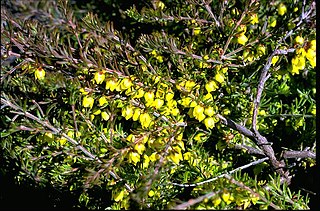
Boronia purdieana is a plant in the citrus family, Rutaceae and is endemic to the south-west of Western Australia. It is a shrub with pinnate leaves and yellow, four-petalled flowers arranged singly in leaf axils.
Cyanothamnus acanthocladus is a plant in the citrus family, Rutaceae and is endemic to a small area in the south-west of Western Australia. It is a low, prickly shrub with small leaves and white, four-petalled flowers.

Boronia capitata, commonly known as the cluster boronia, is a plant in the citrus family, Rutaceae and is endemic to the south-west of Western Australia. It is a slender, spreading shrub with simple leaves and pink, four-petalled flowers.

Cyanothamnus bussellianus is a plant in the citrus family, Rutaceae and is endemic to the south-west of Western Australia. It is a slender perennial herb or shrub with well-spaced, simple leaves and pink, blue or white, four-petalled flowers.

Cyanothamnus defoliatus is a plant in the citrus family, Rutaceae and is endemic to the south-west of Western Australia. It is a straggly shrub with simple, thread-like leaves and white to pink, four-petalled flowers that are pale blue on the back.
Marco Duretto is a manager and senior research scientist at the Royal Botanic Gardens Sydney in Australia.
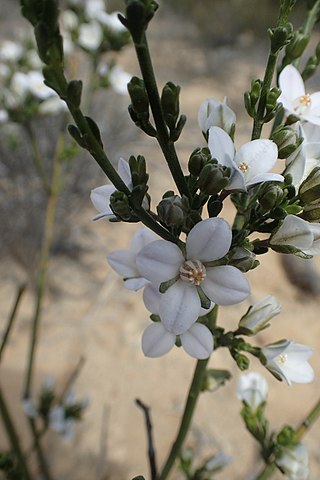
Cyanothamnus fabianoides is a plant in the citrus family, Rutaceae and is endemic to the south-west of Western Australia. It is a compact shrub with many branches, simple, more or less cylindrical leaves and single white, pink or pale blue four-petalled flowers in the leaf axils.

Cyanothamnus inconspicuus is a plant in the citrus family, Rutaceae and is endemic to the south-west of Western Australia. It is a shrub with pinnate leaves and small white or creamy green flowers with four petals and eight stamens and occurs from the Stirling Range to Mount Ragged.

Cyanothamnus inflexus is a plant in the citrus family Rutaceae and is endemic to tablelands near the New South Wales - Queensland border in Australia. It is an erect, woody shrub with pinnate leaves and up to seven white to pink four-petalled flowers in the leaf axils. Boronia bipinnata is similar but has larger, bipinnate or tripinnate leaves and smaller sepals and petals.

Cyanothamnus penicillatus is a plant in the citrus family, Rutaceae and is endemic to the south-west of Western Australia. It is a low, spreading shrub with pinnate leaves and white flowers with four petals and eight stamens.
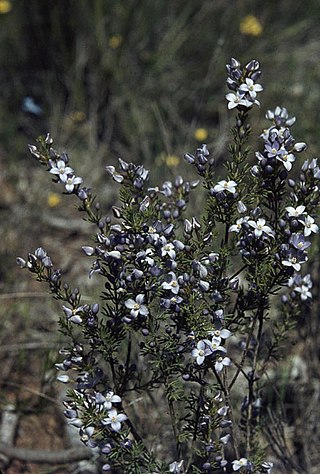
Cyanothamnus ramosus is a species of plant in the citrus family Rutaceae and is endemic to the southwest of Western Australia. It is an erect, mostly glabrous shrub with pinnate leaves with up to seven leaflets, and white, four-petalled flowers with blue or pale green backs.
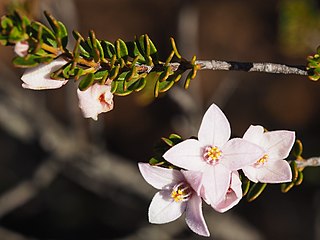
Boronia scabra, commonly known as rough boronia, is a plant in the citrus family, Rutaceae and is endemic to the south-west of Western Australia. It is an open shrub with simple, often clustered, oblong to elliptic leaves, and pink, mostly four-petalled flowers.

Cyanothamnus subsessilis is a species of plant in the citrus family, Rutaceae and is endemic to the south-west of Western Australia. It is a woody, mostly glabrous shrub with simple leaves and flowers with four petals that are white on the front and green to blue on the back.
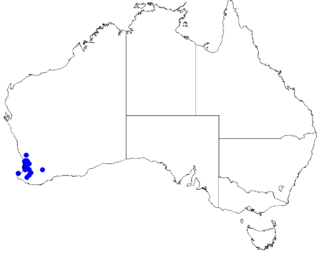
Cyanothamnus tenuis, commonly known as blue boronia, is a species of plant in the citrus family, Rutaceae, and is endemic to the southwest of Western Australia. It is a slender shrub with thread-like, sessile leaves, and flowers with four petals that are white to pink on the front and pale blue on the back.

Boronia wilsonii is an erect shrub that is endemic to northern Australia. Its branches, leaves and backs of the flowers are densely covered with woolly hairs. The petals are white to pink or burgundy-coloured.

Cyanothamnus westringioides is a species of erect shrub that is endemic to a small area in the southwest of Western Australia. It has simple, narrow, sessile leaves and pale pink flowers arranged singly in leaf axils.


















